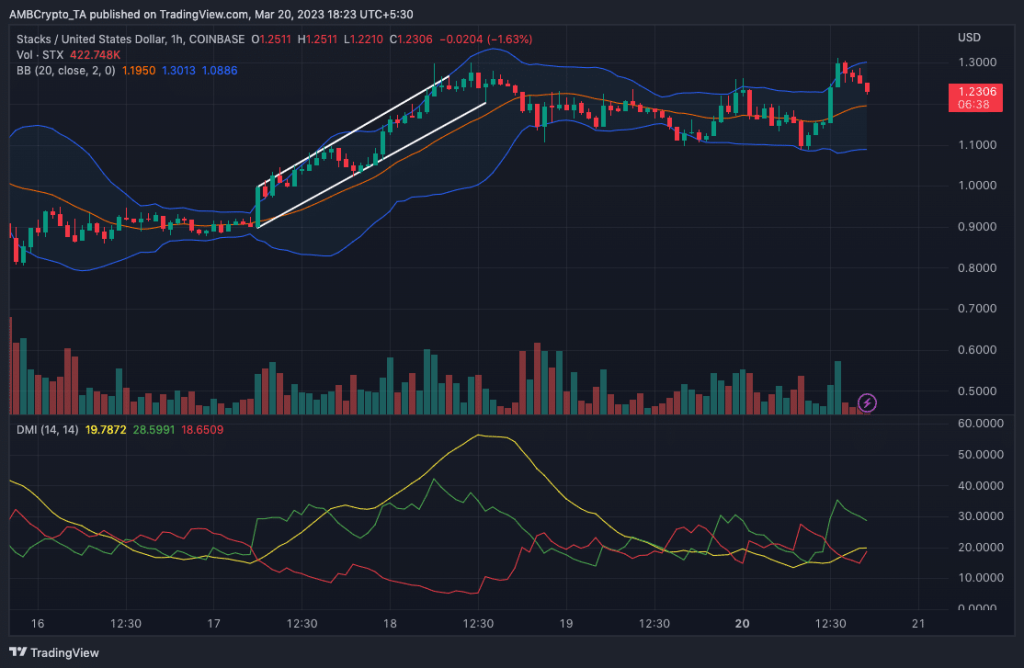- The Bitcoin layer one (L1) settlement project upgraded its network to a new version.
- The king coin seems to have played a significant role in the STX performance, as it tapped an overbought level.
Stacks [STX], known as the Bitcoin [BTC] layer for smart contracts, announced its activation of the 2.1 version on 19 March. In December 2022, the project had upgraded to 2.05, whose goal was to shorten the runtime of a full block creation on the network.
Read Stacks’ [STX] Price Prediction 2023-2024
Clarity as Stacks unlocks
The now-implemented 2.1 upgrades, also called the Stacks Improvement Proposal (SIP) would strengthen Bitcoin bridging and decentralized mining.
???? #Stacks 2.1 Activated ????
Strengthening The Connection to #Bitcoin
⭐️ Stacking Improvements
⭐️ New Clarity Functions
⭐️ Better Bridges
⭐️ Decentralized Mining
⭐️ #Bitcoin-native AssetsFind out more ???? 1/7
— stacks.btc (@Stacks) March 19, 2023
Stacks prides itself on a project for enabling smart contracts and decentralized applications for transaction settlement on the Bitcoin blockchain. And this has been possible because of the Proof of Transfer consensus, which helps Stacks layer hashing, secured by the Bitcoin hash power.
With the new upgrade, Stacks mentioned that the miners would be able to reduce Bitcoin transaction fees by 25%. Also, it would reduce the barrier to entry for decentralized mining pools. The announcement read:
“The 2.1 upgrade adds the ability for miners to mine using a native segwit or taproot UTXO. Not only does this reduce the Bitcoin transaction fee by around 25%, but also this is a major building block for decentralized mining pools”.
Interestingly, Stacks’ link to Bitcoin did not end with mining or smart contracts interaction. Rather, STX has also been on BTC’s heels per price performance.
According to CoinMarketCap, STX shot up by 6.21% following the announcement. This brings the crypto’s performance in the last 30 days to 270% cumulatively.
It is also to be noted that three weeks ago, the token recorded a 165% value hike, and BTC may have played a part in the same. But it would be necessary to evaluate if the king coin can still influence STX for another upside.
STX: A trip to the downside unless…
Based on the technical outlook, STX had been relying on increasing support since 17 March. Although there have been times when the resistance pushed the price downwards, most ended in recovery.
But indications from the Bollinger Bands (BB) revealed that the STX had left the contracting area toward extreme volatility. Furthermore, the STX price was touching the upper band at press time, implying that the cryptocurrency was likely overbought.
Realistic or not, here’s STX’s market cap in BTC’s terms
Additionally, the Directional Movement Index (DMI) reinforced the STX buyers’ supremacy over the sellers. This was ascertained from the -DMI (red) sliding below the +DMI (green).
However, the Average Directional Index (ADX) was 19.78. As such, a continuous movement in the upward direction might experience some scuffles unless the ADX (yellow) certifies it at a value of 25.
![Stacks [STX] price action](https://statics.ambcrypto.com/wp-content/uploads/2023/03/STXUSD_2023-03-20_13-53-22.png)
Source: TradingView

